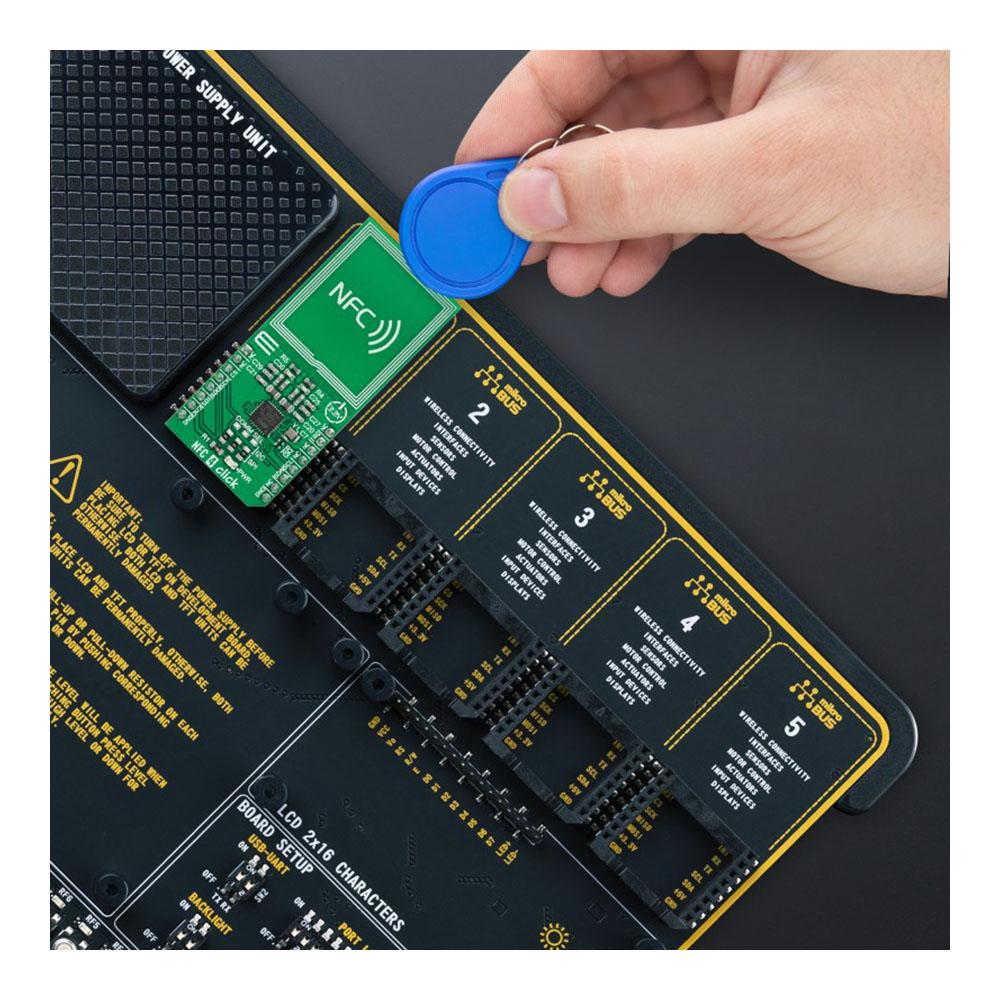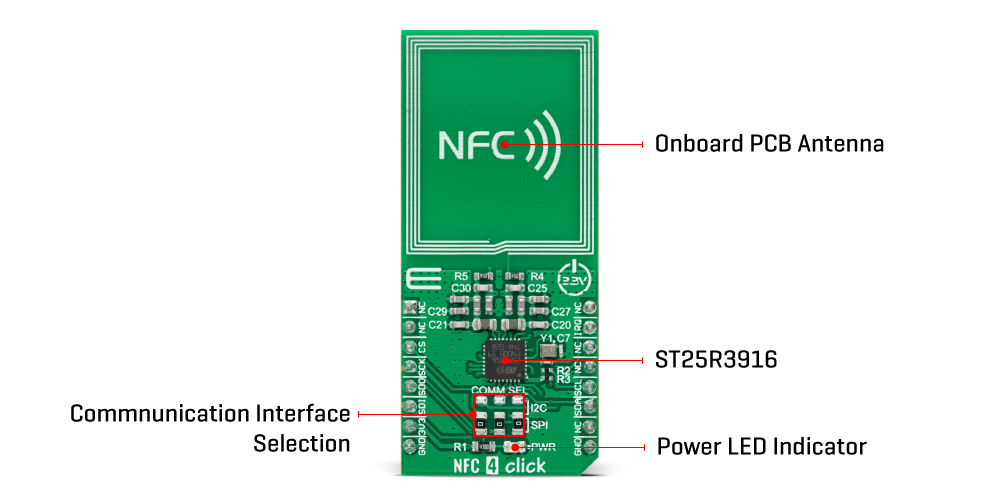Mikroelektronika d.o.o.
Carte NFC 4 Click
Carte NFC 4 Click
Impossible de charger la disponibilité du service de retrait
Le NFC 4 Click Board™ est une carte complémentaire compacte qui contient un émetteur-récepteur NFC pour la communication sans contact. Cette carte comprend le ST25R3916, un émetteur-récepteur NFC polyvalent prenant en charge la fonctionnalité peer-to-peer passive et le mode d'émulation de carte NFC, ainsi que le fonctionnement du lecteur NFC de STMicroelectronics. Il dispose d'une puissance de sortie RF élevée pour piloter directement une antenne gravée sur le PCB, ainsi que son circuit de réglage, avec une efficacité élevée. Le ST25R3916 représente également un lecteur EMVCo entièrement conforme aux normes ISO 14443A/B, ISO 15693, ISO 18092, Felica et NFC Forum.
Grâce au ST25R3916, le NFC 4 Click Board™ fournit toutes les fonctionnalités dont les concepteurs ont besoin pour commercialiser et respecter rapidement les spécifications NFC pertinentes. Cette carte Click board™ représente une solution idéale pour intégrer rapidement la technologie NFC dans toute application personnalisée.







How Does The NFC 4 Click Board™ Work?
The NFC 4 Click Board™ is based on the ST25R3916, a high-performance multi-purpose NFC transceiver supporting NFC initiator, NFC target, reader, and card emulation modes from STMicroelectronics. It features high RF output power to directly drive an antenna etched on the PCB, alongside its tuning circuit, at high efficiency. Besides being fully compliant with EMVCo 3.0, it also includes an advanced analog front end and a highly integrated data framing system for ISO 18092 passive and active initiator and target, NFC-A/B (ISO 14443A/B) reader including higher bit rates, NFC-F (FeliCa™) reader, NFC-V (ISO 15693) reader up to 53 kbps, and NFC-A / NFC-F card emulation. Due to this combination of high RF output power and low power modes, this Click board™ is ideally suited for infrastructure NFC applications.

The ST25R3916 features a built-in A/D converter, which input can be multiplexed from different sources used for the diagnostic functions and the low power card detection. The result of the A/D conversion is stored in a register that can be read through the selectable host interface. It also contains a low-power capacitive sensor to detect the presence of a card without switching on the reader field by measuring the amplitude or phase of the antenna signal. Also, an integrated low power RC oscillator and a wake-up timer automatically wake up the ST25R3916 and check for a presence of a tag using one or more techniques of low power detection of card presence (capacitive, phase, or amplitude).
The NFC 4 Click Board™ communicates with a microcontroller either via an SPI interface or via an I2C interface. The ST25R3916 acts as a slave device on both interfaces, relying on the microcontroller to initiate all communication. The communication selection can be made by positioning SMD jumpers labeled as COMM SEL to an appropriate position. Note that all the jumpers' positions must be on the same side, or the Click board™ may become unresponsive. This Click board™ also features an additional interrupt signal routed on the INT pin of the mikroBUS™ socket to notify the microcontroller of completed commands or external events (e.g., peer device field on).
The NFC 4 Click Board™ can be operated only with a 3.3V logic voltage level. The board must perform appropriate logic voltage level conversion before use with MCUs with different logic levels. However, the Click board™ comes equipped with a library containing functions and an example code that can be used, as a reference, for further development.
Specifications
| Type | RFID/NFC |
| Applications | Can be used for rapidly integrating NFC technology in any custom application |
| On-board modules | ST25R3916 - high-performance multi-purpose NFC transceiver supporting NFC initiator, NFC target, reader, and card emulation modes from STMicroelectronics |
| Key Features | Low power NFC active and passive target modes, low power capacitive and inductive card detection, fully compliant with EMVCo 3.0, noise suppression, selectable communication interfaces, and more |
| Interface | I2C,SPI |
| Compatibility | mikroBUS |
| Click board size | L (57.15 x 25.4 mm) |
| Input Voltage | 3.3V |
Pinout Diagram
This table shows how the pinout on the NFC 4 Click Board™ corresponds to the pinout on the mikroBUS™ socket (the latter shown in the two middle columns).
| Notes | Pin |  |
Pin | Notes | |||
|---|---|---|---|---|---|---|---|
| NC | 1 | AN | PWM | 16 | NC | ||
| NC | 2 | RST | INT | 15 | IRQ | Interrupt | |
| SPI Chip Select | CS | 3 | CS | RX | 14 | NC | |
| SPI Clock | SCK | 4 | SCK | TX | 13 | NC | |
| SPI Data OUT | SDO | 5 | MISO | SCL | 12 | SCL | I2C Clock |
| SPI Data IN | SDI | 6 | MOSI | SDA | 11 | SDA | I2C Data |
| Power Supply | 3.3V | 7 | 3.3V | 5V | 10 | NC | |
| Ground | GND | 8 | GND | GND | 9 | GND | Ground |
Onboard settings and indicators
| Label | Name | Default | Description |
|---|---|---|---|
| LD1 | PWR | - | Power LED Indicator |
| JP1-JP2 | COMM SEL | Lower | Communication Interface Selection SPI/I2C: Lower position SPI, Upper position I2C |
NFC 4 Click Board™ Electrical Specifications
| Description | Min | Typ | Max | Unit |
|---|---|---|---|---|
| Supply Voltage | - | 3.3 | - | V |
| RF Speed | - | - | 848 | kbps |
| Operating Temperature Range | -40 | +25 | +105 | °C |
Software Support
We provide a library for the NFC 4 Click Board™ as well as a demo application (example), developed using MikroElektronika compilers. The demo can run on all the main MikroElektronika development boards.
The package can be downloaded/installed directly from NECTO Studio Package Manager(recommended way), downloaded from our LibStock™ or found on Mikroe Github account.
Library Description
This library contains API for the NFC 4 Click Board™.
Key Functions
nfc4_get_mifare_tag_uid- This function reads the UID of a mifare tag.nfc4_write_register- This function writes a desired data to the selected register.nfc4_read_register- This function reads a desired data from the selected register.
Example Description
This example demonstrates the use of the NFC 4 Click Board™ by reading MIFARE ISO/IEC 14443 type A tag UID.
void application_task ( void )
{
uint8_t tag_uid[ 10 ] = { 0 };
uint8_t uid_len = 0;
if( NFC4_OK == nfc4_get_mifare_tag_uid( &nfc4, tag_uid, &uid_len ) )
{
log_printf( &logger, " Tag UID: " );
for ( uint8_t cnt = 0; cnt < uid_len; cnt++ )
{
log_printf( &logger, "%.2X", ( uint16_t ) tag_uid[ cnt ] );
}
log_printf( &logger, "rn" );
Delay_ms( 500 );
}
}
The full application code, and ready to use projects can be installed directly from NECTO Studio Package Manager(recommended way), downloaded from our LibStock™ or found on Mikroe Github account.
Other mikroE Libraries used in the example:
- MikroSDK.Board
- MikroSDK.Log
- Click.NFC4
Additional notes and informations
Depending on the development board you are using, you may need a USB UART click, USB UART 2 click or RS232 click to connect to your PC, for development systems with no UART to USB interface available on the board. The terminal available in all MikroElektronika compilers, or any other terminal application of your choice, can be used to read the message.
mikroSDK
The NFC 4 Click Board™ is supported with mikroSDK - MikroElektronika Software Development Kit. To ensure proper operation of mikroSDK compliant Click board™ demo applications, mikroSDK should be downloaded from the LibStock and installed for the compiler you are using.
Software Support
We provide a library for the NFC 4 Click Board™ as well as a demo application (example), developed using MikroElektronika compilers. The demo can run on all the main MikroElektronika development boards.
The package can be downloaded/installed directly from NECTO Studio Package Manager(recommended way), downloaded from our LibStock™ or found on Mikroe Github account.
Library Description
This library contains API for the NFC 4 Click Board™.
Key Functions
nfc4_get_mifare_tag_uid- This function reads the UID of a mifare tag.nfc4_write_register- This function writes a desired data to the selected register.nfc4_read_register- This function reads a desired data from the selected register.
Example Description
This example demonstrates the use of the NFC 4 Click Board™ by reading MIFARE ISO/IEC 14443 type A tag UID.
void application_task ( void )
{
uint8_t tag_uid[ 10 ] = { 0 };
uint8_t uid_len = 0;
if( NFC4_OK == nfc4_get_mifare_tag_uid( &nfc4, tag_uid, &uid_len ) )
{
log_printf( &logger, " Tag UID: " );
for ( uint8_t cnt = 0; cnt < uid_len; cnt++ )
{
log_printf( &logger, "%.2X", ( uint16_t ) tag_uid[ cnt ] );
}
log_printf( &logger, "rn" );
Delay_ms( 500 );
}
}
The full application code, and ready to use projects can be installed directly from NECTO Studio Package Manager(recommended way), downloaded from our LibStock™ or found on Mikroe Github account.
Other mikroE Libraries used in the example:
- MikroSDK.Board
- MikroSDK.Log
- Click.NFC4
Additional notes and informations
Depending on the development board you are using, you may need a USB UART click, USB UART 2 click or RS232 click to connect to your PC, for development systems with no UART to USB interface available on the board. The terminal available in all MikroElektronika compilers, or any other terminal application of your choice, can be used to read the message.
mikroSDK
The NFC 4 Click Board™ is supported with mikroSDK - MikroElektronika Software Development Kit. To ensure proper operation of mikroSDK compliant Click board™ demo applications, mikroSDK should be downloaded from the LibStock and installed for the compiler you are using.
Carte NFC 4 Click
Frequently Asked Questions
Have a Question?
Be the first to ask a question about this.







